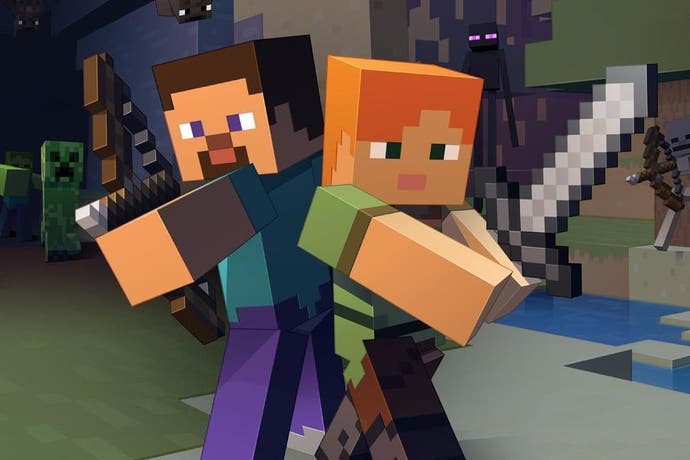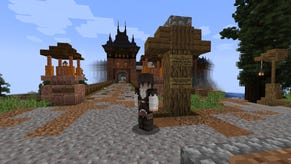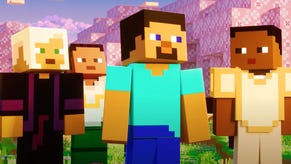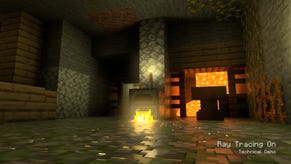Face-Off: Minecraft on Switch takes on PlayStation 4
Resolution is locked to 720p, but the package still compares favourably overall.
As one of the best-selling games of all time, Minecraft is available on virtually every relevant platform - but Switch is the first to bring seamless support for gaming both at home and on the go. Nintendo's console hybrid is powerful enough to offer Minecraft's top-tier visual feature set but at the same time, it also offers up anything up to four-player split-screen action, even in portable mode - something completely unique to this version. In practice though, just how does the experience stack up to the other console editions? And to set the bar as high as we can, can it compare favourably with the PS4 release?
There are some limitations, but Switch users can rest easy - it's an impressive conversion overall. This latest Minecraft edition arrives comes via 4J Studios, and is based on the full-fat console experience, complete with most of the visual bells and whistles you'll find on PS4. That includes the same texture quality, features like ambient occlusion, the smooth lighting mode, and cloud rendering.
However, the one big drawback is resolution - as reported already, Minecraft on Switch does indeed operate at native 720p no matter how you play, and as usual with the series, there's no anti-aliasing whatsoever. Bearing in mind we're getting a true 1080p output from games like Mario Kart 8 while docked, it does come as a disappointment - at least at first. An update from Microsoft reveals that "[this] isn't a question of system power, but stems from issues currently experienced shifting from one resolution to another while docking and undocking."
It's a curious statement, because no other Switch game so far has had problems changing resolutions while moving to and from the dock, and such functionality should be built into the core system APIs - in fact, it's one of the core foundations of the entire system. Being able to tap into Switch's higher GPU clocks while docked is one of the system's key selling points, and a way to get more from a game when connected to an HDTV. Minecraft on Switch runs smoother when docked, so it's definitely tapping into the higher clocks available. We approached 4J Studios directly about this, who confirmed that "Minecraft: Nintendo Switch Edition is running at a native 720p in both docked and undocked modes. We are investigating supporting native 1080p when docked, as a possible future update."
We may or may not get 1080p in the end, but a few other interesting points were revealed in this exchange as well. For starters, 4J Studios confirms Minecraft is indeed using Switch's maximum GPU mode while portable, which Nintendo developer documentation we've seen pegs at 384MHz, compared to the lower, alternative 307.2MHz mode. Using these higher clocks, 60fps is a confirmed priority on Switch too, whether that's in portable mode or not. And to achieve this, all visual settings are kept precisely the same whether docked or undocked, except in one area: rendering distance.
Rendering distance is easily one of the biggest factors in Minecraft's performance. Thousands of individual cubes draw simultaneously, but when you take Switch out of the dock, the game dials back this setting back to introduce more pop-in. To explain, one 'chunk' in Minecraft equals 16x16 blocks on the x and y axis, with a 256 block height. According to the developer's livestream, the Switch in docked mode renders 11 or 12 of these chunks overall. However, when in portable mode, that lowers to seven chunks.
In our video presentation, you'll see that difference in motion and it makes for a big contrast: whole buildings are in view while docked that only appear when you move closer when playing in portable mode. However, it's worth stressing that viewing directly on Switch's smaller screen makes the difference less apparent. Yes, you'll see barren areas ahead, but it's still a big step up over other portable versions of the game - for example, the Vita version only pushed out five chunks overall.
Focusing on the docked single-player experience, Switch's 11/12 chunk limit manages to hold up nicely against the PS4 and Xbox One versions, which both operate using 18 chunks. In built-up areas like the tutorial level, with lots of occluding buildings and mountains, it's hard to catch the difference - not impossible, but clearly the balancing point chosen by 4J works out well here. The only area where you'll really notice the limit is when flying around in the Creative mode, but that goes for all editions of the game to a certain extent. And for perspective, the PC version still trumps all others in this area, with the Windows 10 beta letting you run at a 22 chunk render distance - which largely eliminates the issue.
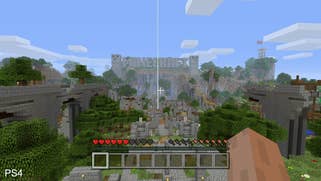

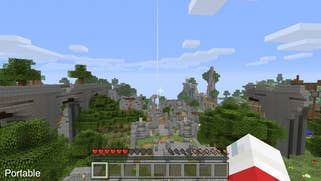
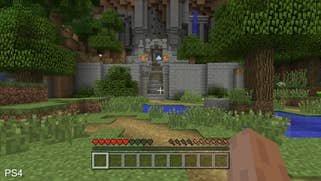

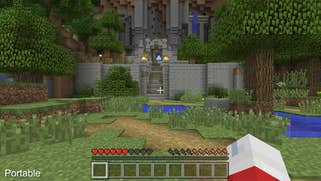
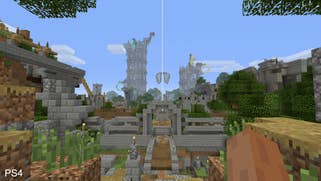

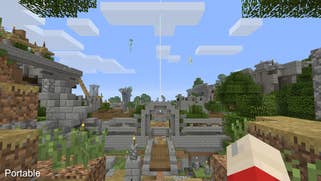
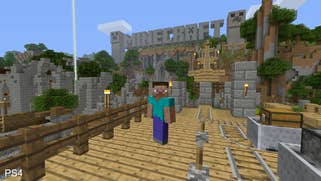
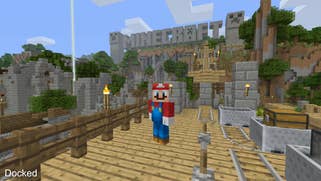
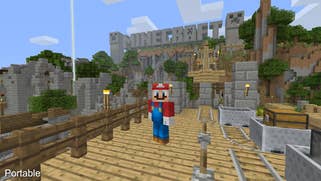
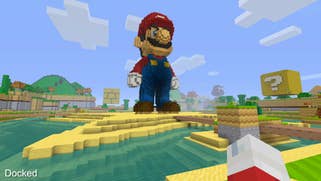

Elsewhere, the Switch version is also sensibly pared back in terms of its maximum world size. When creating a world, Switch gives you the medium setting as the maximum option. This is 3072x3072 blocks for the entire world size on Switch - and to be clear, that's not the viewable distance, but everything potentially rendered within the world until you hit the end. Now, 3072x3072 is a massive increase over Wii U's classic setting of 864x864. And equally, it's a big step up over last-gen machines like PS3 and 360, which use 1024x1024. But inevitably, it does falls short of the 'large' setting possible on more powerful machines like PS4 and Xbox One, which use 5120x5120. Again, it's a limit on Switch, but one you're less likely to be distracted by.
But the new release does have its own exclusive series of features. For a fun twist it includes a new Mario-themed texture pack alongside several others. You get a pre-made level, with a separate skin set for characters like Mario, authentic music from the series and a revamped HUD - a great touch. Alongside this, Switch also offers up to four-player support in split-screen, and eight networked. Uniquely, this four-player split even works in its portable mode, giving each player a 360p resolution window to play with while on the go. It's difficult to control this way bearing in mind the diminutive nature of the Switch's screen, and ideally you'll have it docked to maximise the view of each window. But the fact that four-player split-screen is included at all in portable mode is remarkable.
There are shortcomings too though - some of them based on the lack of OS-level functionality. For one, Switch has no in-game chat support just yet. Also, inviting friends while online isn't straightforward either - again an area hopefully addressed with future updates. Switch also misses the amplified terrain option you have on PS4 and Xbox One, a feature that generates huge mountains, hitting near the peak of the map. It's a RAM-intensive feature, meaning PS4 and Xbox One can tap into it without much issue. But clearly with Switch's lower 4GB of memory it's a stretch too far on performance, and it's not here.
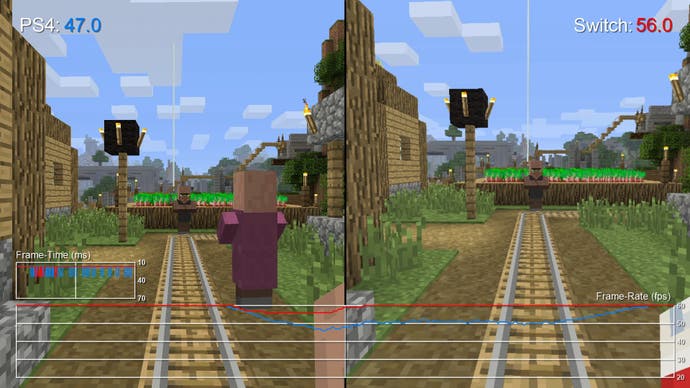
But there's definitely a sense of swings and roundabouts here. While the Switch version's 720p resolution is a clear downgrade, there is some evidence to suggest that the Switch version may have a better handle on its 60fps target frame-rate overall compared to other versions - we found some detailed scenes in single-player mode where the docked Switch runs faster than PlayStation 4 running like-for-like content (albeit at its reduced settings). Performance issues manifest more prominently in split-screen mode - as expected - but again, we found that Switch was smoother overall, with lurches down from the target 60fps less pronounced than they are on PlayStation 4. However, understandably, draw distances are further pared back in the multiplayer modes. For the record, while Minecraft has no PS4 Pro support, it is possible to engage boost mode and this eliminated all the performance issues we encountered.
Docked vs portable performance is also intriguing. Rendering range is reduced to seven 'chunks', which does a lot in preserving performance, but regardless you will still see more jarring drops down to the 30fps line, while docked frame-rates in identical scenarios can see consistent 60fps gameplay. These jumps in refresh feel jarring, but this isn't common enough to be a major issue - it's a little wobbly overall, but not to an extent that's going to upset gameplay. Split-screen modes see draw distances reduced still further, and performance is even more variable to the point where a 30fps cap really would have made a lot of since here - especially once you go all-out with four players.
Ultimately, there are obvious shortcomings on Switch, both in resolution and draw distance - but fact is it's the most adaptable version of the game out there. On top of the drop-in, drop-out local multiplayer which debuted on Xbox 360, 4J Studios now has Minecraft make an equally easy transition from a console experience to handheld. That comes with visual compromise, but the end result still hangs together well. Of course, a full 1080p mode while docked would help - but the question is whether performance would be further compromised with such an upgrade. But as things stand, 4J has delivered - this is almost everything you could want from Minecraft in one 'play anywhere' package.
